We can also make an equivalent for parallel circuits in two systems - electrical and magnetic.
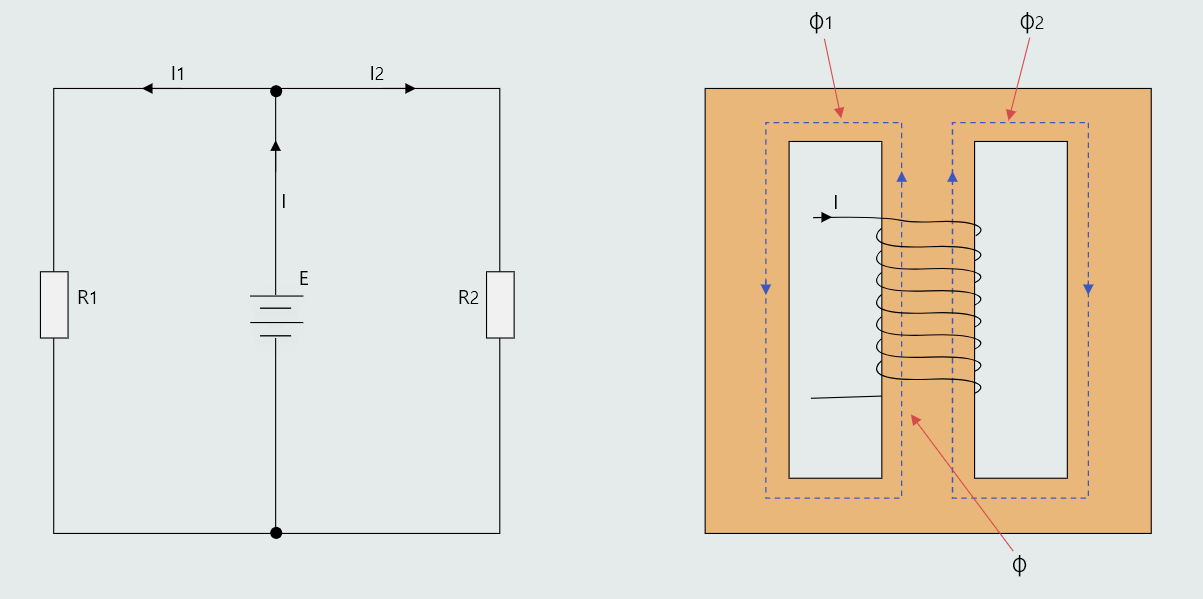
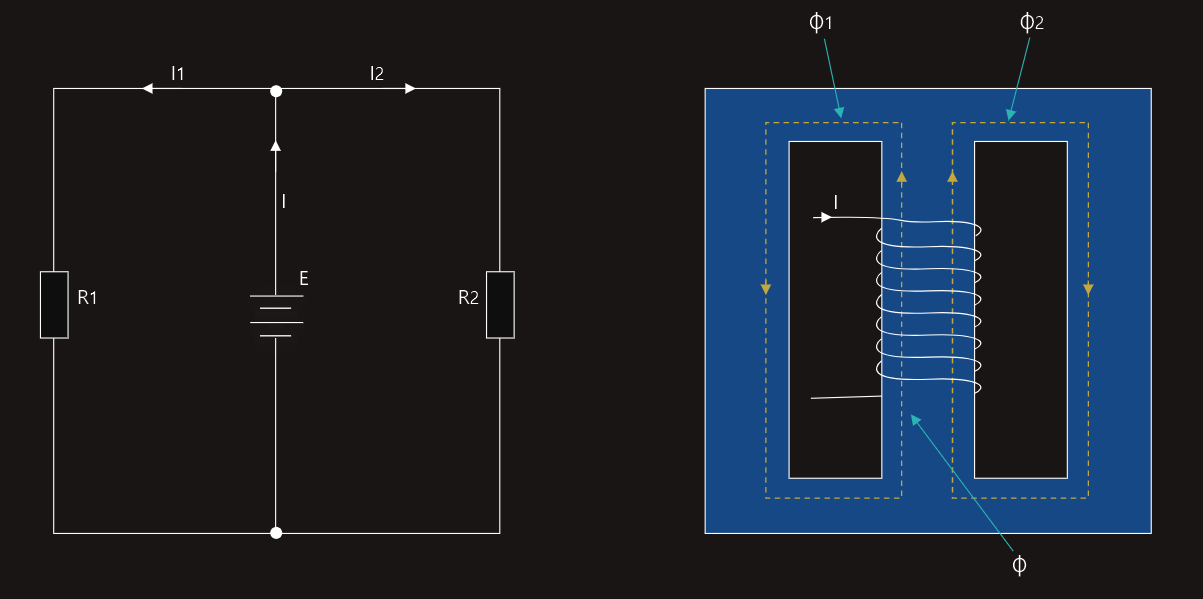
In this case we have the following:
1. In the electrical circuit, the current supplied by the source of emf splits between the two outer branches according to the resistances offered. In the magnetic circuit, the flux produced by the mmf splits between the outer limbs according to the reluctances offered.
2. If the two resistors in the outer branches are identical, the current splits equally. Similarly, if the reluctances of the outer limbs are the same then the flux splits equally between them.
We have assumed here that the source of emf is ideal (no internal resistance) and that the connecting wires have no resistance. The latter assumption cannot be applied to the magnetic circuit. All three limbs will have a value of reluctance that must be taken into account when calculating the total circuit reluctance.
Whenever a bar magnet is broken in half, two new magnets are created, no matter how many times this is repeated. The reason for this is that no pole can exist in isolation. All magnets exist as dipoles – they always have pairs of poles.
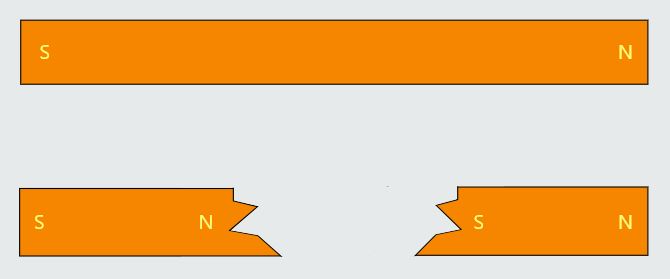
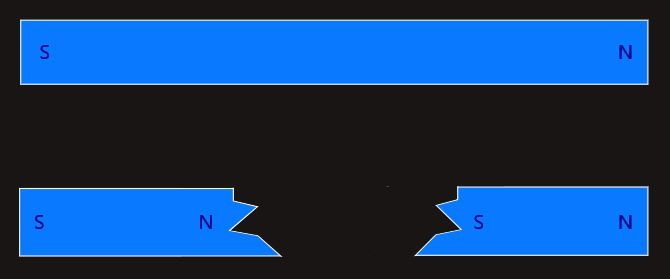
German scientist Wilhelm Eduard Weber theorized that if this action could be repeated often enough, then we would ultimately arrive at a molecule, or even an atom, which would behave just like a tiny bar magnet. This ‘molecular magnet’ was eventually termed a ‘domain’ and this, in turn, led to what has became known as the Domain Theory of Magnetism.
Magnetism - The Earth is a magnet
Magnetism is one of the most important phenomena in the study of electricity. It is the force used to produce most of the electrical power in the world. This force was first discovered by Greeks when they noticed that a certain type of stone was attracted to iron. This stone was first found in Magnesia in Asia Minor and was named magnetite.
The first compass was invented when it was noticed that a piece of magnetite, placed on a piece of wood floating in water, always aligned itself north and south. This is because the Earth itself contains magnetic poles, that is shown on the illustration below.
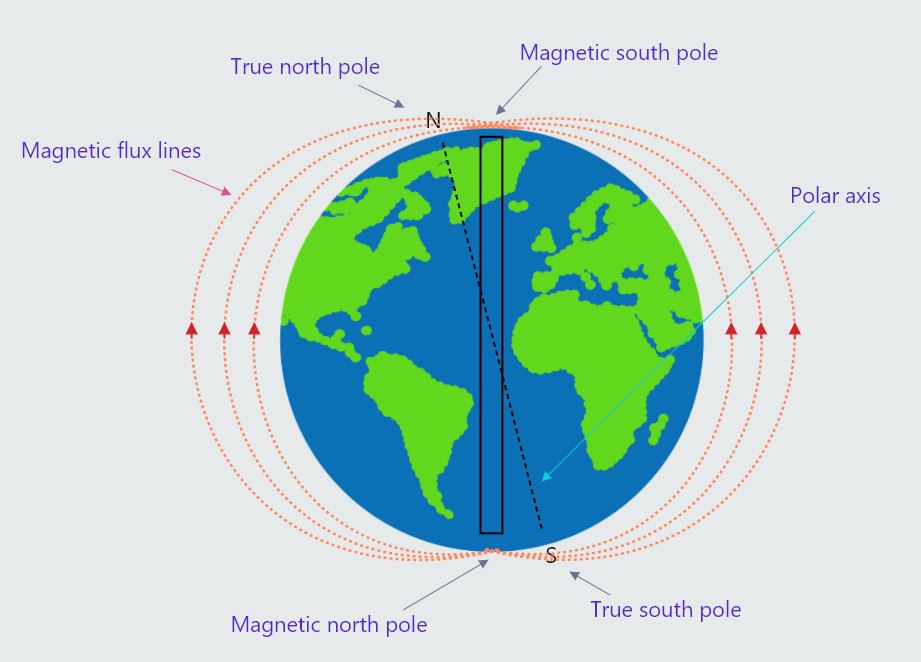
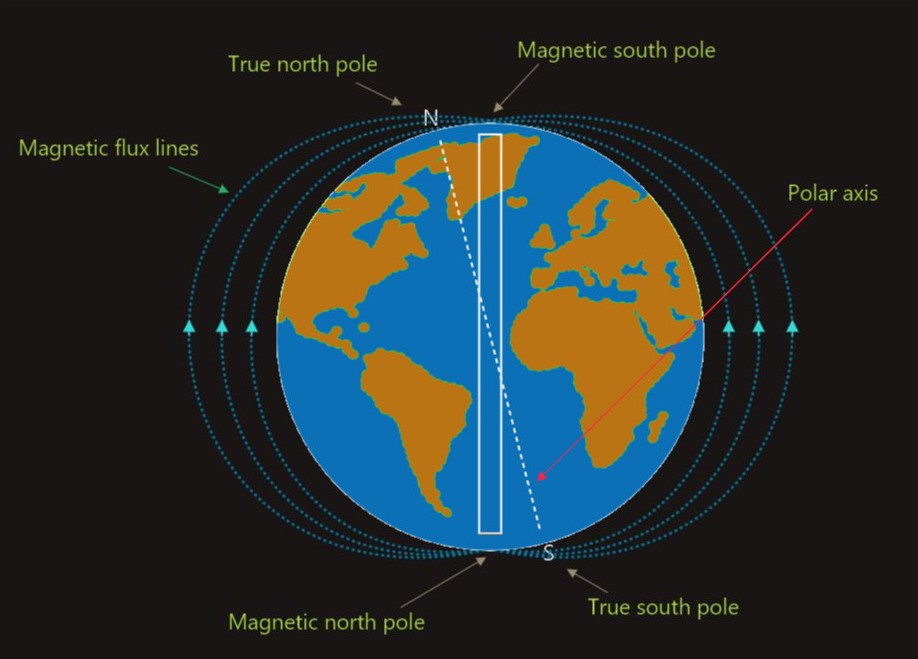
We should notice that magnetic north is not located at the true North Pole of the Earth.
The angular difference between the two is known as the angle of declination.
This is the reason that navigators must distinguish between true north and magnetic north and when using compasses, must always compensate for when plotting their routes. This angle is continuously changing! So if we were to follow our compass North today, we would arrive at a different place than we would have arrived at, say, 10–15 years ago! Accordingly, navigation charts are regularly updated to incorporate changes in the angle of declination.
The illustration shows the magnetic lines of force to be only on each side of the Earth, but the lines actually surround the entire Earth like a magnetic shell.
Also, the magnetic north pole is located near the southern polar axis and the magnetic south pole is located near the northern polar axis.
The reason that the geographic poles (axes) are called north and south is because the north pole of a compass needle points in the direction of the north geographic pole.
The fundamental law of magnetism states that ‘like poles repel, and unlike poles attract’. Since unlike magnetic poles attract, the north magnetic pole of the compass needle is attracted to the south magnetic pole of the Earth.
So the Earth behaves as though it has a ‘gigantic bar magnet’ buried deep within its surface, with its south magnetic pole located in the Northern hemisphere, and its north magnetic pole located in the Southern hemisphere. And a compass needle doesn’t actually point to the Earth’s geographic or True North pole at all, but to a nearby location which we call ‘Magnetic North’. It’s very important to understand that ‘Magnetic North’ is the name we give to that location to distinguish it from True North, and is not the magnetic polarity at that location! The reason that the compass acts in this way is, as we just mentioned, because the Earth itself behaves as though it contains a gigantic bar magnet buried deep within its surface – with its axis slightly displaced from the Earth’s axis of rotation.
Magnetic devices
There is a very long list of devices that operate on magnetism. Some of the more common devices are electromagnets, measuring instruments, inductors, transformers, and motors. We will now take a look at working principle of the speaker.
The speaker is a common device that operates on the principle of magnetism.
The speaker produces sound by moving a cone; the movement causes a displacement of air. The tone is determined by how fast the cone vibrates. Low or bass sounds are produced by vibrations in the range of 20 cycles per second. High sounds are produced when the speaker vibrates in the range of 20,000 cycles per second.
The speaker uses two separate magnets: permanent magnet and an electromagnet. The permanent magnet is held stationary, and the electromagnet is attached to the speaker cone. When current flows through the coil of the electromagnet, a magnetic field is produced. The polarity of the field is determined by the direction of current flow. When the electromagnet has a north polarity, it is repelled away from the permanent magnet, causing the speaker cone to move outward and displace air. When the current flow reverses through the coil, the electromagnet has a south polarity and is attracted to the permanent magnet. The speaker cone then moves inward and again displaces air.
The number of times per second that the current through the coil reverses determines the tone of the speaker.
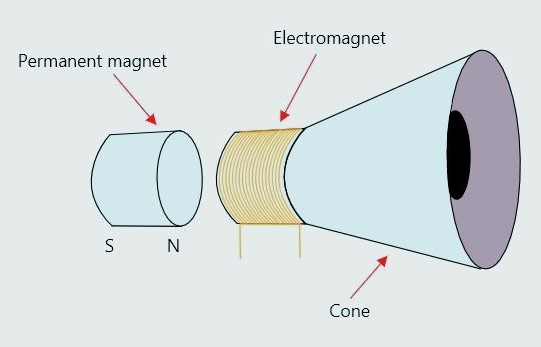
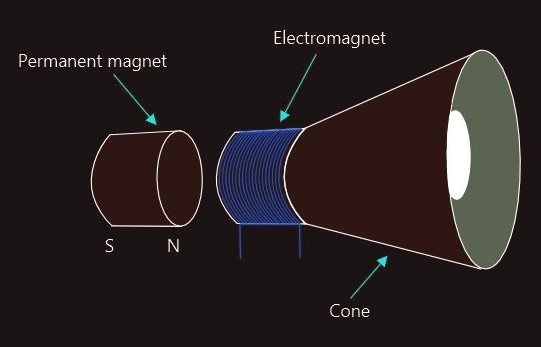
Demagnetizing
When an object is to be demagnetized, its molecules must be disarranged as they are in a nonmagnetized material. This can be done by placing the object in the field of a strong electromagnet connected to an AC line. Since the magnet is connected to AC, the polarity of the magnetic field reverses each time the current changes direction. The molecules of the object to be demagnetized are aligned first in one direction and then in the other. If the object is pulled away from the AC magnetic field, the effect of the field becomes weaker as the object is moved farther away. The weakening of the magnetic field causes the molecules of the object to be left in a state of disarray. The ease or difficulty with which an object can be demagnetized depends on the strength of the AC magnetic field and the coercive force of the object.
When the current flow through the coil of a magnet is stopped, some magnetism may be left in the core material. The amount of magnetism left in a material after the magnetizing force has stopped is called residual magnetism. If the residual magnetism of a piece of core material is hard to remove, the material has a high coercive force. Coercive force is a measure of a material’s ability to retain magnetism. A high coercive force is desirable in materials that are intended to be used as permanent magnets. A low coercive force is generally desirable for materials intended to be used as electromagnets.
The object can also be demagnetized by striking and by heating.
If a magnetized object is struck (with a hammer, for example), the vibration often causes the molecules to rearrange themselves in a disordered fashion; it may be necessary to strike the object several times.
Heating also demagnetizes an object. When the temperature becomes high enough, the molecules rearrange themselves in a disordered fashion.
Electromagnetism
Faraday’s Law of Electromagnetic Induction
Faraday's law is best to be considered in two interrelated parts:
- The value of emf induced in a circuit or conductor is directly proportional to the rate of change of magnetic flux linking with it.
So, if there is no change in flux, or the way in which this flux links with a conductor, then no emf will be induced. - The polarity of such an emf, induced by an increasing flux, is opposite to that induced by a decreasing flux.
We will now consider a coil of wire, a permanent bar magnet and a galvanometer as illustrated on the right.
When the magnet is being moved so that it enters the center of the coil, it will be noticed that the pointer of the galvanometer deflects in one direction. This deflection of the pointer is only momentary, since it only occurs whilst the magnet is moving. The galvanometer is a current measuring device. However, any current flowing through it must be due to a voltage between its terminals. Since there is no other source of emf in the circuit, then it must be concluded that an emf has been induced or created in the coil itself. The resulting current indicated by the galvanometer depends on the value of this emf. It will also be observed that when the magnet is stationary (either inside or outside the coil) the galvanometer does not deflect. Hence, emf is induced into the coil only when the magnet is in motion.
When the magnet is withdrawn from the coil, the galvanometer will again be seen to deflect momentarily. This time, the deflection will be in the opposite direction. Provided that the magnet is removed at the same rate as it was inserted, then the magnitudes of the deflections will be the same. The polarities of the induced emfs will be opposite to each other, since the current flow is now reversed.
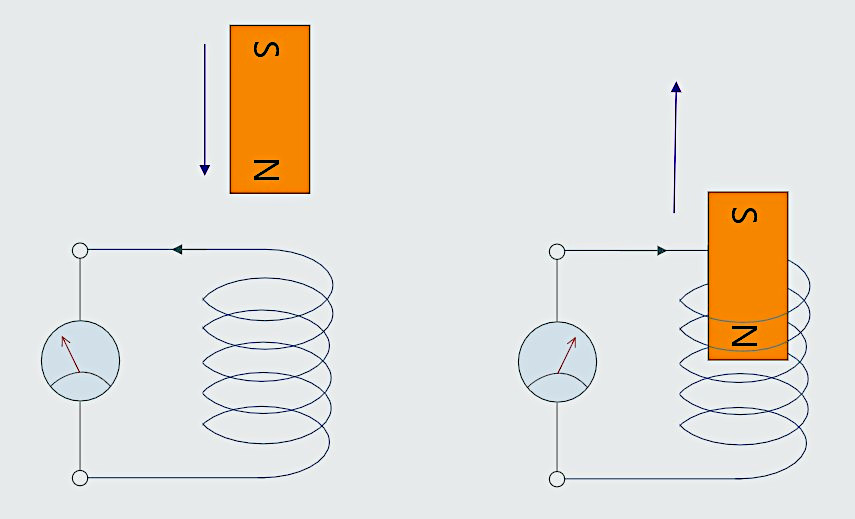
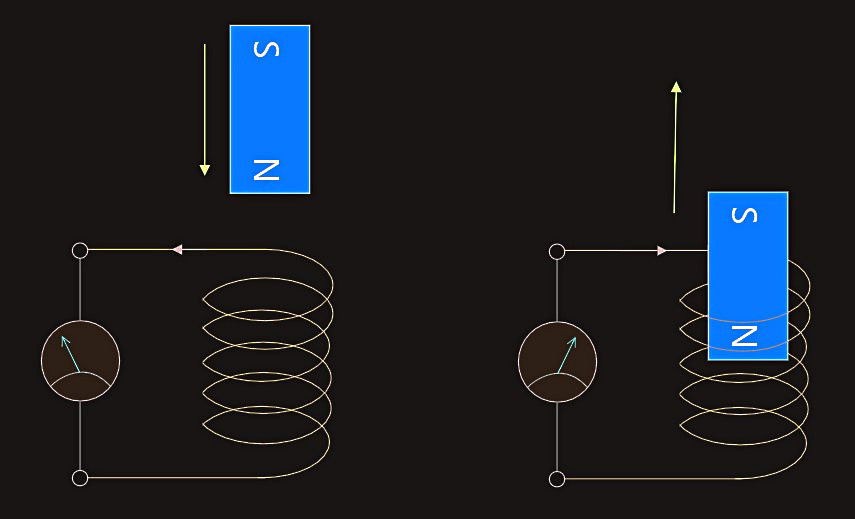
The Faraday Cage
A Faraday cage is a metallic enclosure that protects the inside from electromagnetic fields.
The Faraday cage works on the principal that charge exists only on the surface of a conductor. As an electric field is applied to a conductive surface, charge accumulates on the surface of the conductor. This means that charge cannot penetrate the inside of the cage, protecting the contents from any electric and electromagnetic interferences. A side effect to the behavior of the Faraday cage is that any charge that is created inside the cage also cannot escape to the outside.







